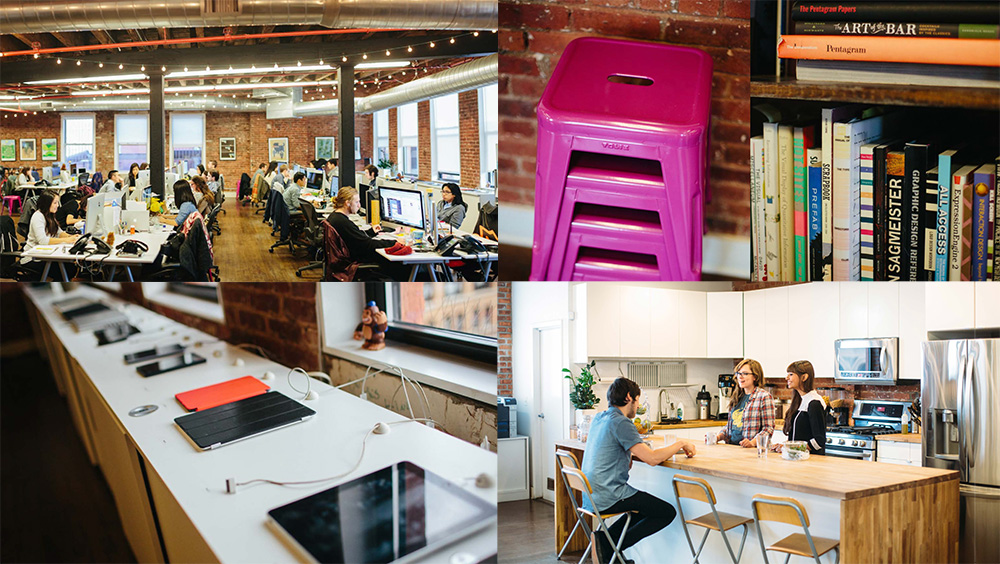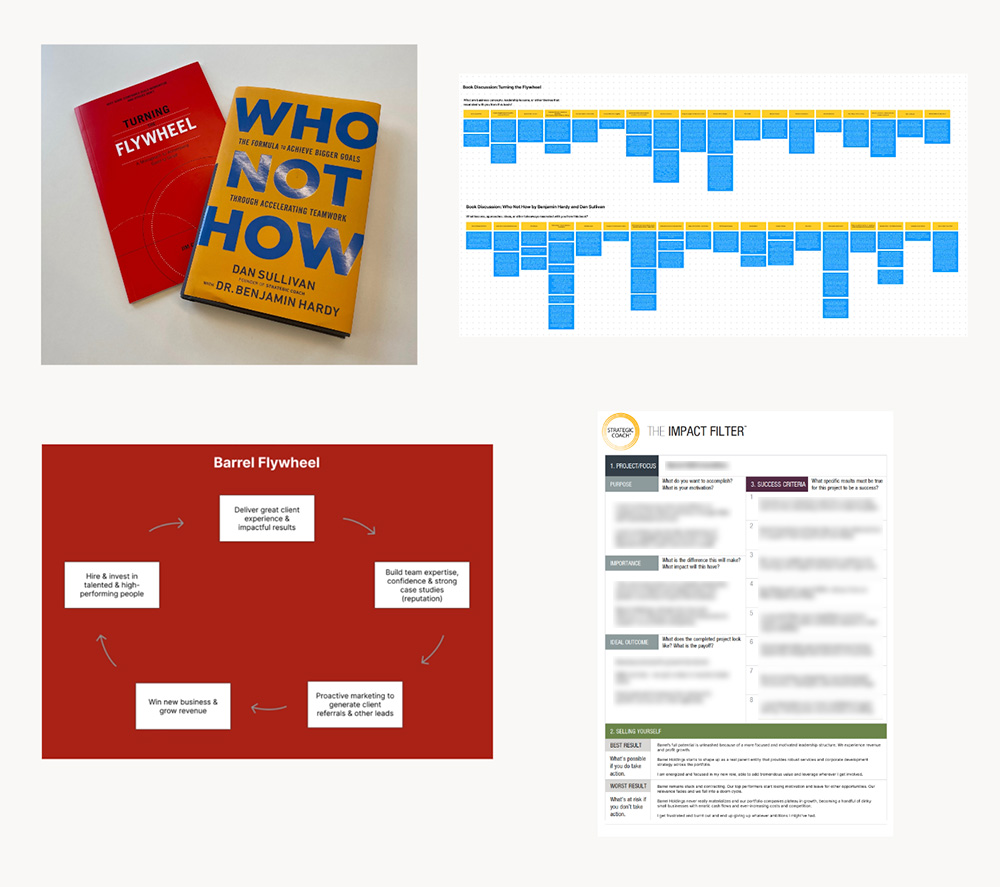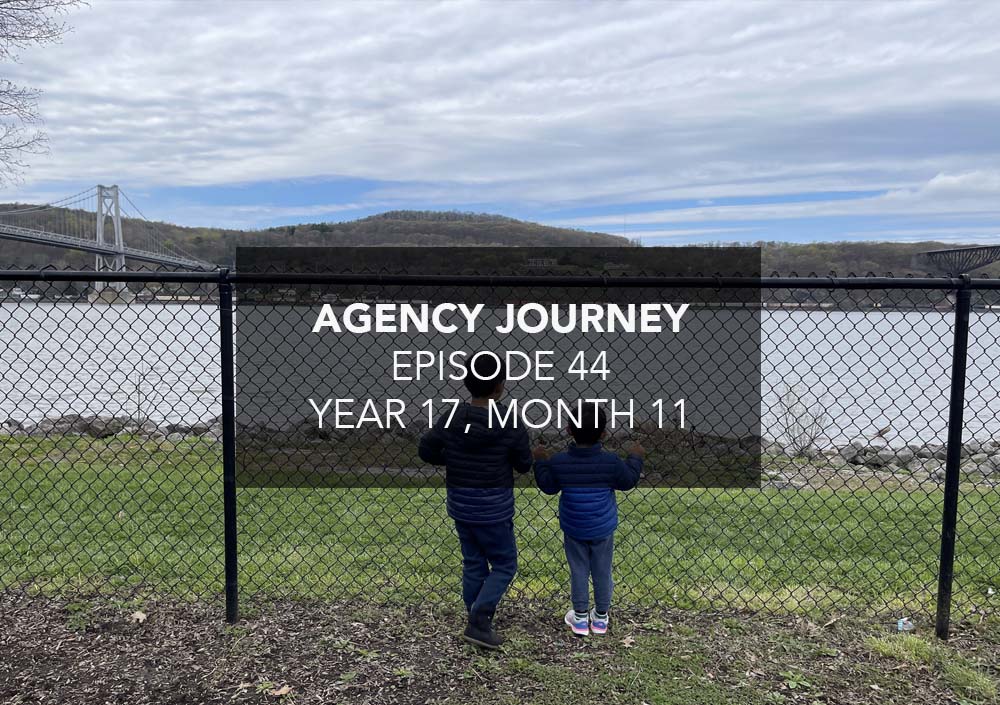This is the final month of our lease at our 197 Grand Street office. Next week, we’ll be completely moved out. We’ll be renting a desk and conference room access from our friends at The Working Assembly.
It was in 2011 that we first moved to 197 Grand Street. I was on my honeymoon when Sei-Wook orchestrated the move (God bless him, he’s also orchestrating the move out).
We were on the 6th floor in a space three times the size of our former office. In less than 1 year, we outgrew that office and jumped at the opportunity to take over a bigger space on the 7th floor. We put in all kinds of care and touches to make the space feel like a cool place to work and hang out. It was, after all, the age of kegerators and ping pong tables in the office (culture, right? tsk tsk).

These are a few pics from my favorite photo shoot of the Barrel office, around 2013 when we first moved up to the 7th floor.
In 2019, we had the opportunity to take over the entire floor, knocking down the walls and creating additional space for our content studio and a handful of really beautiful conference rooms. Of course, just a few short months later, COVID would come and we’d go permanently remote. It was too bad that we never really got to fully use our space for more than a few months.
We started subletting the office in 2021 in order to offset the pricey rent. I would occasionally bike in from Brooklyn once or twice a week, making sure I had in-person meetings every time I came in. I once made the mistake of coming in on a day that was full of Zoom meetings. It was awful – I wasted time commuting only to spend 8 hours inside a Room box. I vowed not to make that mistake again.
After moving up to Rhinebeck last summer, I came into the office less and less. It was only when the Barrel partners got together for our quarterly book club meetings that it momentarily felt like 2019 all over again. A bygone era.
I’m sure we’ll have a grand time at our new spot in Flatiron or maybe we’ll start having quarterly meetings in more exotic locations. But 197 Grand will have a special place in my heart – it’s where I did a lot of growing up, where I experienced so many memorable moments in my life.
About Agency Journey: This is a monthly series detailing the happenings at my agency Barrel, founded in 2006. You can find previous episodes here.
Highlights
Slow Start to the Quarter
After a strong finish to Q1 in signing new clients, we struggled to sign a new client as of this writing in Q2. We have a deal with a major brand that’s in the contract stages for an initial project that’s been dragging with legal. We’ve got 3 proposals we’re waiting to hear back on and 4 proposals in progress. This is all for new logos. Lead volume has been normal, about 7 inbound leads per week.
We’ve had better progress on the existing accounts side, signing a number of extensions to our ongoing support and optimization retainers as well as some one-off projects. But even here, we’re a bit behind pace and could use a handful of larger projects (in progress) to get signed.
Looking at deals signed the past 6 months, the average deal age was around 4.5 months. This is something we need to adjust our forecasts and expectations to: whenever a new opportunity comes through the door, we should expect that it’ll take over a quarter to materialized into a signed project. Another data point: looking at deals we’ve lost, it usually took us about 2 months to find out that we lost.
Takeaway: be patient with signing new clients, continue to grow existing accounts.
Our Continued Search for a Sales Lead
As I mentioned last month, Lucas has been leading the charge interviewing numerous candidates for our Sales Lead role. We’ve landed on a game plan where the Sales Lead will be heavily focused on lead gen for the first 6 months, learning our ICP, co-creating messaging, and putting in systems and processes to identify and reach prospects. The Sales Lead will then begin to take part in helping to qualify and then eventually close deals with the assistance of our team’s subject matter experts and leaders. We can see the Sales Lead overseeing a business development representative (BDR) resource or agency later on and being a full-cycle salesperson.
We’ve arrived at this plan through dozens of conversations with candidates, coaches, and other agency leaders. There’s no guarantee we’ll see the results we have in mind, but we’re committed to investing in this and learning from what transpires. We hope to make a hire in May but no rush, we have to feel really good about the hire.
Partners Book Club
Another wonderful session with the Barrel partners as we met to discuss a couple of books that we read together: Who Not How: The Formula to Achieve Bigger Goals Through Accelerating Teamwork by Dan Sullivan and Benjamin Hardy and Turning the Flywheel: A Monograph to Accompany Good to Great by Jim Collins.
Who Not How became an instant eye-opener for us. The concept of creating a vision and then finding a “who” to help us achieve it was so simple yet powerful. There are so many things we try to do on our own where we are bogged down trying to figure out the “how”, but we can achieve so much more by finding the “who” to more effectively get things done. By leveraging the “whos” in our lives, we’re able to realize our visions more quickly. Also, we in turn can serve as a “who” to others pursuing their visions.

Our Barrel partners book club in action: having read 2 books, we discussed & shared lessons and themes we noticed and also did a couple of applied exercises.
I thought about all the times over my career where I tried to “figure it out on my own” versus clearly defining a vision and searching for someone to help me. I spent 2 years trying to teach myself paid marketing on the side in order to offer it at Barrel. What resulted was a poorly run and poorly conceived service offering from the start. It wasn’t until I brought a more qualified consultant later on that we could level up, but by then, we had missed out on some key opportunities.
The partners and I used Dan Sullivan’s “Impact Filter” to practice the creation of a clearly defined vision that could then be used to enlist a “who”. This was a very productive exercise and one that we’ll be using with our team in the future.
Turning the Flywheel was a quick refresher of the flywheel concept that featured prominently in Jim Collins’s classic Good to Great. A flywheel is a set of activities that, when properly defined, sequenced, and executed, can generate really powerful momentum for an organization. We tried our hand at creating our own flywheel examples in order to check our understanding and to see how it can be applied do various aspects of Barrel.
Barrel Holdings Q1 2024 Updates
The leaders from our Barrel Holdings agencies met to share results from Q1 and outlook for Q2. Bolster, Barrel, and Vaulted Oak all came up short of Q1 goals that we had set at the start of the year. With Bolster we’re still ironing out our services offering and target audience. We’ve been doubling down on the Omakase (our free brand design sprint) as a customer acquisition offer but need to keep experimenting to find a way to monetize those who receive the free work.
Vaulted Oak and Barrel are feeling the effects of some long-time clients ramping down and/or going away, which puts pressure on new business and other accounts to make up for the lost revenue. It’ll most likely be a rough first half of the year, but I think by late Q3/early Q4, it’s possible that the clients we’re adding now and starting to grow can help make up the slack. Just need to keep executing on all facets of the business.
The brightest spot this past quarter was BX Studio. It achieved record levels of revenue, gross profit, net profit and new business signed in Q1. We’re ahead of pace and may even adjust our goals upward to set our sights higher for the year. The demand for Webflow implementation services has been quite high and the BX team has done a great job of delivering for clients and continuing to burnish its reputation.
This quarter’s meeting was a reminder to me that there’s still a lot of work to be done when it comes to providing support across the holding company. Barrel continues to take up the lion share of my attention with Bolster coming in second. BX, as it scales, will require more support in building out infrastructure through more robust processes and more talent, things Sei-Wook and I can help BX CEO Jacob with. There’s also a lot we can do to drive more opportunities and build more partnerships for Vaulted Oak.
Top of Mind
The Need to Meet in Person
It’s been a busy month of travel for me. I’ll have attended three conferences in back to back weeks along with a couple of trips down to NYC in April. Things will calm down in May but I’m convinced that I ought to be doing more in-person meetings with people on a regular basis.
Video calls allow for efficiency and volume, but the typical 30-minute cut-off often has a rushed quality to it that can prevent deeper connections from forming. Combine that with 6-8 calls per day that go by in a blur and it’s hard to really remember or feel anything afterwards. Taking good notes and having 2nd, 3rd, and 4th follow-up calls goes a long way in building some kind of relationship, but nothing compares to an in-person hang with someone. A walk outside together, a shared meal, or even an hour-long convo in a conference room all seem to open up more possibilities for greater mutual understanding and potential collaboration.
If building relationships with key people is one of the highest leverage things I can do for all of our agencies, then it’s a no-brainer for me to make the time to proactively meet with people in person. Travel is often challenging with 3 young kids at home, but New York City is a couple of hours away. With advanced planning, I can stack 4-5 in-person meetings in a day, often with people who are passing through and in town on business.
Whether it’s clients, new business contacts, prospective new hires, agency peers, or strategic partners (tech, investors, other agencies), it’s very clear to me that an in-person meeting, especially in early trust-building stages, can be hugely beneficial.
Throughout April, I found myself having more interesting and un-rushed interactions with people I met at conferences. Those whom I had known only through video calls in the past gained new dimensions in my mind as we spent time in person.
I still think video calls are great for communicating regularly with team members and clients we know very well, but there’s definitely a case to be made that we can benefit by investing in occasional in-person meet-ups among employees and with our clients.
Shared with Partners
“In closing, I’ll offer this: don’t waste a second of your life. You only have 40,000 days to live. The longer you live, the quicker time goes. To a toddler, 10 minutes feels like 10 years. To a 90-year-old man, 10 days feels like half a second. Examine who in your life is eating up your precious seconds. Who around you complains but doesn’t act? Ask yourself, “What is my real passion? Where do I thrive? Where can I give the most back to the world?” We get too hung up on what our social values and morals say we should do, what our parents or friends say we should do. For this reason, I’m always impressed by people who live their own great life.” (Chip Wilson, Little Black Stretchy Pants)
The key takeaway in this quote is actually taking the time to ask yourself the questions about your passion and how you want to impact the world. If I’m being honest with myself, I haven’t paused and reflected on these questions enough. A part of me at times feels inspired to think big, set impossible goals, and have a grand vision for who I can be. Another part of me often feels the pull of a life where not wanting (no desires), simplicity, and humility are the core values. All this striving for a “great” life – what does it all matter in the end? I think it’s been a good tension for me, even if it comes at the cost of achieving more externally lauded milestones.
“There is magic in being in the present in your life. I’m always amazed at the power of clear observation simply about what’s going on, what’s true. Finding out the exact details of your personal finances, clarifying the historical data about the company you’re buying, or getting the facts about who really said what to whom in an interpersonal conflict can be constructive, if not absolutely necessary and downright healing.” (David Allen, Getting Things Done)
I love this characterization of “being present” vs. the everyday use I hear that refers more to not being on the phone and paying attention to whatever is in front of you. It’s still very possible to be attentive to what’s in front of you and yet still be in denial about what’s actually going on. For example, one might look enthusiastically engaged in a discussion about the company’s finances but avoid confronting the brutal truth about its failing performance, downplaying the true state of things or tabling more serious discussions.
“Tolerations are the things that you’re putting up with that you actually have the ability to resolve and yet you still choose to ignore. Tolerations are things that literally suck and drain your attention and your energy. They always live in the back of your mind from the minute you get up in the morning to the moment you fall asleep. They sometimes live after that in bad dreams. They are like mind parasites.” (Dusan Djukich , Straight-Line Leadership)
Related to the quote about being present, tolerations are also an indication that you’re not being present in your life but instead putting off uncomfortable conversations or actions.
“Let’s say you have a person who’s outperforming a higher-paid employee. You have two choices. If the higher-paid employee represents the true market value, you have to raise the lower-paid employee to that salary level. If the higher-paid employee isn’t worth the money, you have to either transition that employee out of the business or find a way to improve that employee’s performance. In rare cases, I have lowered the pay of the underperformer, but that is usually a short-term fix until that person chooses to leave.” (Greg Crabtree, Simple Numbers, Straight Talk, Big Profits!)
In our line of business, because we don’t sign people to complicated long-term contracts like they do in sports*, you can actually run a very meritocratic system where top performers are the highest paid employees and underperforming employees are quickly transitioned out. But this is very difficult to execute because it requires a culture that has incredibly high standards and committed leaders who are unafraid to have difficult conversations about performance and make unpopular decisions.
* Sports-wise, I’m referring to the lag that often happens when a team signs a player largely based on their past performance. In the best cases, a big salary is a perfect match for the player through the life of the contract as they match or exceed expectations. In other cases, the player’s performance declines with age, injuries, or mismatch in scheme/chemistry, making the contract seem like a bad decision. In worst-case scenarios, a highly paid player on the roster may be unplayable, taking up valuable salary cap space while the team tries to make do with lesser paid players. Teams try to move off of these “bad” contracts by trying to trade players (the NBA does this a lot, where rebuilding teams will trade for bad contracts to tank their records and position themselves for high draft picks). Some leagues (like the NFL) offer contracts with non-guaranteed money to give them the option to cut players much sooner with less penalty.
